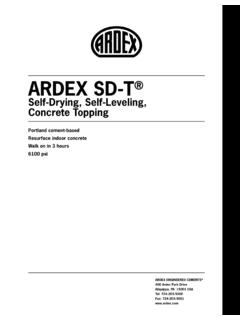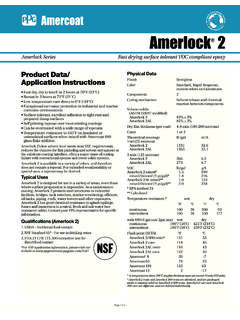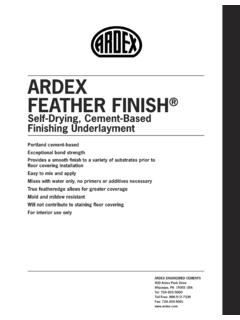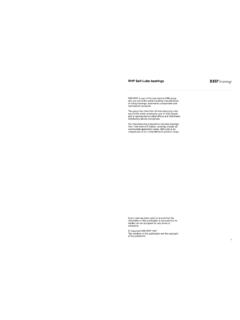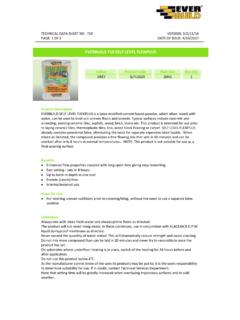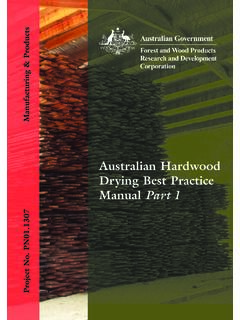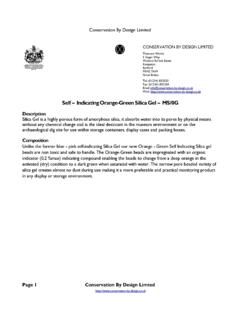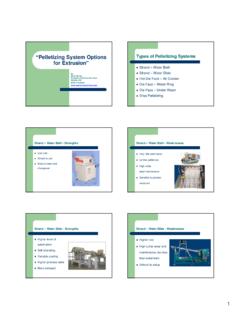Transcription of CASE STUDY: SLUDGE DRYING USING A VOLUTE …
1 8th Annual WIOA NSW Water Industry Operations Conference & Exhibition Page No. 73 PCYC in Orange, 1 to3 April, 2014 case study : SLUDGE DRYING USING A VOLUTE dehydrator Paper Presented by: Keith Appleby Author: Keith Appleby, Manager Integrated Water & Sustainability Services, Glen Innes Severn Council 8th Annual WIOA NSW Water Industry Operations Conference and Exhibition PCYC in Orange, 1 to 3 April, 2014 8th Annual WIOA NSW Water Industry Operations Conference & Exhibition Page No. 74 PCYC in Orange, 1 to3 April, 2014 case study : SLUDGE DRYING USING A VOLUTE dehydrator Keith Appleby, Manager Integrated Water and Sustainability Services, Glen Innes Severn Council ABSTRACT Glen Innes Severn Council operates a 7000 EP intermittent decanted extended aeration treatment plant serving the town of Glen Innes in northern NSW.
2 The plant was upgraded from a trickling filter arrangement in 2007, however SLUDGE DRYING equipment was not included in that upgrade due to budget constraints. The new facility produced a greater volume of SLUDGE , and a VOLUTE dehydrator was installed in 2013 to cope with the daily SLUDGE SLUDGE at the Glen Innes plant is varies from 2%- 4% solid content. The VOLUTE dehydrator is a low energy, continuous feed process that raises the solid content to between 12% and 20% depending on operator preference. The resulting product is a moist cake consistency able to be transported by tipper truck. The technology is a direct replacement for belt press or centrifuge, and uses a polymer to coagulate the SLUDGE in a flocculation tank.
3 The coagulated SLUDGE is then massaged in a rotor stator arrangement, whereby the stator consists of many plates that allow water but not solid to escape the VOLUTE . INTRODUCTION The sewer treatment facility at Glen Innes was upgraded in 2007 to improve discharged effluent quality. Historically the plant had been a trickling filter process with digestion of SLUDGE , followed by DRYING of the SLUDGE on sand DRYING beds. These beds were constructed with subdrainage pipes, and a combination of drainage and evaporation removed the water content. The dried biosolid was then removed by manual labour.
4 Mechanical removal USING a skid steer loader or similar was not possible as the subdrainage pipe work was not capable of withstanding that load. The new process involved the typical intermittent decanted extended aeration philosophy. During the aeration phase of the cycle mixed liquor is pumped to one of two lagoons, where it settles as a SLUDGE of similar consistency to gravy. Supernatant is returned via a gravity overflow to the aeration stage. With cleaner effluent came a greater volume of SLUDGE . Glen Innes is located at an elevation of 1150 meters in a high rainfall cool climate environment. Generally evaporation rates are low in comparison to other parts of New South Wales, and SLUDGE DRYING beds were limited in their ability to achieve the task.
5 After just a few years it became evident that SLUDGE was accumulating in the two SLUDGE lagoons at a faster rate than could be removed in the DRYING beds. Initially a biological treatment was applied to the lagoons. This involved the application of a biological treatment with surface aeration. The system appeared to be successful for 12 months, but then suddenly stopped working. Later analysis revealed an amount of the contaminant Dieldrin in that batch of SLUDGE , it is presumed that was the cause of the failure. 8th Annual WIOA NSW Water Industry Operations Conference & Exhibition Page No. 75 PCYC in Orange, 1 to3 April, 2014 SLUDGE accumulated quickly, and this was not noticed until staff observed that the supernatant return line had become blocked.
6 When the blockage was cleared, the lagoon was overfull and a serious incident unfolded. SLUDGE discharged via the supernatant return pipe to the treatment process and caused a major upset to the IDEA treatment process. This situation required immediate attention, and a centrifuge was brought in to process SLUDGE . The single treatment cost approximately $140,000, but gave time for future works to be planned and Options were considered including routine contracting of a centrifuge. It was estimated that if the DRYING beds were not used at all that a clean out would be required each six months. At this stage the option of a VOLUTE dehydrator was presented to council by a supplier.
7 The benefits of the process were determined to be a low energy cost, low wear rate of equipment as the parts are very slow moving, and the replacement of a significant amount of manual labour (perhaps of one position). Figure 1: VOLUTE dehydrator DISCUSSION As a new technology in Australia, use of a VOLUTE dehydrator was somewhat experimental. The machine itself is quite self-contained, user friendly and simply does what it is supposed to without attention. The associated processes of getting SLUDGE to the machine, dosing polymer and getting SLUDGE cake away were unknowns and had to be designed for purpose. Polymer Dosing Council elected to install a liquid polymer dosing system.
8 This involves blending the liquid polymer with 4-5 L/s of water and feeding that mix into the flocculator tank. 8th Annual WIOA NSW Water Industry Operations Conference & Exhibition Page No. 76 PCYC in Orange, 1 to3 April, 2014 Figure 2: TOMAL liquid polymer dosing system Polymer is a significant cost in the process, accounting for approximately $7,000 per year for a 7000 EP plant. SLUDGE Delivery SLUDGE is fed to the dehydrator by a submersible pump/mixer unit mounted on a floating pontoon. The pontoon was an existing unit that was previously used to transfer SLUDGE to the sand DRYING beds. The pump is capable of delivering up to 10 l/s which is far in excess of the maximum feed rate of the dehydrator .
9 The system design allows for overflow of SLUDGE to be returned to the lagoon. Variable speed drives were fitted to both the mixer and the pump to optimise power consumption and minimise return SLUDGE . The dehydrator model in use is able to receive up to 3000 litres per hour. Figure 3: Pontoon mixing pump with variable speed drive 8th Annual WIOA NSW Water Industry Operations Conference & Exhibition Page No. 77 PCYC in Orange, 1 to3 April, 2014 Cake Removal Cake is discharged onto a stainless steel conveyor purchased second hand ex food industry. The conveyor delivers onto a tipping truck. Cake is then stockpiled at this stage.
10 Investigations are underway to determine whether the biosolid is appropriate for incorporation into a compost USING other streams of organic waste diverted from landfill. Aluminium concentration is high, however, due to the use of aluminium based coagulants in the sewage treatment stage and in the dehydrator stage. Figure 4: SLUDGE cake delivery Production Rates The treatment process at Glen Innes produces 60 100kl of excess mixed liquor per day. The mixed liquor suspended solids concentration is typically 4000mg/l, so the dry weight of solids produced daily is around 240 400kg. Settling in the SLUDGE lagoons increases the solids content to between 2% and 4%.



